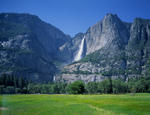MAMMOTH HOT SPRINGS, WY – Elk numbers in Yellowstone National Park’s northern herd are fewer compared to last year, however the population remains above the 10-year average and other recent counts. Low calf survival will likely impact the population over the next two years, according to a population survey conducted last month.
The Northern Yellowstone Cooperative Wildlife Working Group conducted its annual late winter classification of the northern Yellowstone elk population on March 17-19, 2019. The survey was conducted from a helicopter by staff from the Montana Department of Fish, Wildlife & Parks, which is part of the Working Group. Typically, an annual trend count is conducted by fixed-wing aircraft to count the total number of elk, and a separate helicopter survey is conducted to classify elk by age and sex in order to estimate calf and yearling bull survival and ratios of mature bulls in the population. This year the surveys were combined, and elk were counted and classified by helicopter.
All observed elk were counted across the survey area, and when possible staff also classified elk by age and sex. This survey was conducted consistently with the 2016 classification survey in order to assess population changes over the past three years. Survey conditions were favorable across the region, however winter conditions were severe, and many elk were observed to be in poor condition.
Staff counted 5,800 elk, including 1,361 elk (23.5 percent) inside Yellowstone National Park and 4,149 elk (71.5 percent) north of the park. The total count of 5,800 elk was 23 percent lower than the 7,579 elk observed during the 2018 trend count, and 23 percent lower than the 7,510 total elk counted during the 2016 classification survey, but higher than the 10-year average count of 5,399 elk. The long-term average of observed elk numbers since surveys began in 1976 is 10,634 elk, with a peak high count of 19,045 elk in 1994 and a low count of 3,915 elk observed in 2013.
Of the 5,800 elk counted, staff classified 5,510 elk by age and sex, resulting in ratios of 15.2 calves, 5.2 yearling bulls and 12.6 brow-tined bulls per 100 cows. Calf and yearling bull ratios were lower than recent surveys and long-term averages. Brow-tined bull ratios were higher than recent surveys, but below long-term average. Staff observed 16 percent fewer cows, 46 percent fewer calves and 42 percent fewer yearling bulls as compared to the 2016 classification survey. Brow-tined bull numbers increased by 21.3 percent from 432 observed in 2016 to 524 observed in 2019.
This is the second consecutive year with calf ratios below the threshold of 20 calves per 100 cows considered necessary to maintain a stable population. It is likely that additional winter mortalities will occur into spring, further reducing overall numbers and recruitment. Below-average yearling bull and calf recruitment is likely to result in lower numbers of brow-tined bulls being recruited into the population over the next two years.
Though overall elk numbers are down this year as compared to 2018, it is not unusual to observe fluctuations in numbers of elk counted due to survey quality, elk movements and sightability of elk, which vary with conditions. Trends in elk populations are best assessed by considering multiple years of survey data together. The trend for this population has been increasing since 2013; this is the first yearsince 2013 that elk numbers have fallen from the previous year. The Working Group will continue to monitor trends of the northern Yellowstone elk population and evaluate the relative contribution of various components of mortality, including predation, environmental factors and hunting.
The Working Group was formed in 1974 to cooperatively preserve and protect the long-term integrity of the northern Yellowstone winter range for wildlife species by increasing our scientific knowledge of the species and their habitats, promoting prudent land management activities, and encouraging an interagency approach to answering questions and solving problems. The Working Group is comprised of resource managers and biologists from the Montana Department of Fish, Wildlife & Parks; National Park Service (Yellowstone National Park); U.S. Forest Service (Custer Gallatin National Forest); and U.S. Geological Survey-Northern Rocky Mountain Science Center in Bozeman.
2019 late winter survey of northern Yellowstone elk
All posts are those of the individual authors and the owner
of this site does not endorse them. Content should be considered opinion
and not fact until verified independently.
Sorry, only registered users may post in this forum.



